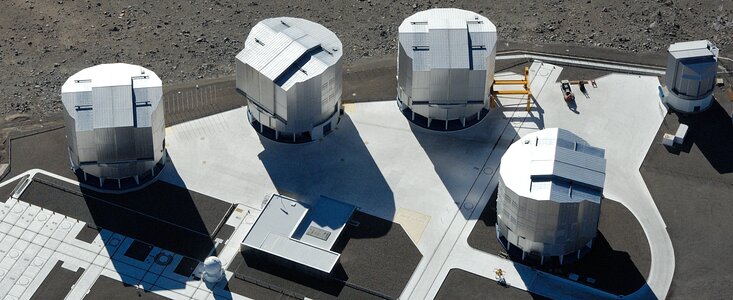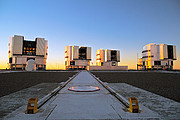Tiedote
ESO:n Very Large Telescope interferometri on tehnyt havaintoja jo kahden vuosikymmenen ajan: Hyvää syntymäpäivää VLTI!
29. lokakuuta 2021
Kaksikymmentä vuotta sitten ESO:n Chilessä sijaitsevan Paranalin observatorion Very Large Telescope eli VLT:n kahden 8,2-metrisen yksikköteleskoopin keräämä valo yhdistettiin ensimmäistä kertaa. Tapahtuma oli historiallinen hetki, jolloin nämä kaukoputket toimivat ensimmäistä kertaa todellisena interferometrinä, mikä merkitsi tähtitieteen uuden aikakauden alkua.
Kun kahden UT:n valonsäteet yhdistettiin yöllä 29. lokakuuta 2001, VLTI ei ainoastaan aloittanut loistavaa toimintaansa, vaan se teki myös ensimmäiset tieteelliset tuloksensa. Se mittasi eteläisen tähtitaivaan tähden Achernarin koon, jonka todettiin olevan noin kymmenen kertaa Aurinkoamme suurempi. Tätä seurasi vielä kolme yötä tieteellisiä havaintoja, joiden aikana VLTI esitteli hienoa potentiaaliaan ja mittasi kymmenen tähteä lisää. Aivan erityisesti se teki ensimmäisen interferometrisen havainnon kiehtovasta Eta Carinaesta.
VLTI:n konsepti oli osoitettu jo joitakin kuukausia aiemmin toimivaksi 17. maaliskuuta 2001. Sinä yönä toisesta tähdestä, kirkkaasta Siriuksesta, tuleva valo kerättiin kahdella pienellä teleskoopilla (nimeltään siderostaatit) ja yhdistettiin. Nämä rakennettiin erityisesti varhaisia VLTI:n testivaiheita varten.
Siderostaattien ja myöhemmin UT:eiden keräämän valon yhdistäminen oli vasta interferometrin toiminnan alku. VLTI voi myös käyttää neljää liikuteltavaa halkaisijaltaan 1,8-metristä aputeleskooppia (AT), jotka valmistuivat vuosina 2004—2006. Helmikuussa 2005 kahden AT:n valo yhdistettiin ensimmäistä kertaa, mikä merkitsi toista tärkeää virstanpylvästä interferometrin toiminnassa. AT:eiden keräämää valoa voidaan yhdistää samalla tavalla kuin UT-teleskooppien, sillä erotuksella, että AT-teleskooppeja voidaan siirtää jopa 30:een eri paikkaan Paranalin operointitasanteella. Tämä mahdollistaa täysin uusia interferometrisiä konfiguraatioita, joiden avulla VLTI saavuttaa täyden havaintopotentiaalinsa.
UT:eiden tai AT:eiden keräämän valon yhdistäminen mahdollistaa sen, että VLTI voi toimia yhtenä ”virtuaalisena”-instrumenttina, jonka läpimitta on yhtä suuri kuin yksittäisten teleskooppien välinen etäisyys (jota kutsutaan ”perusviivaksi”). Interferometriä käytetään tällä hetkellä enintään 140 metrin perusviivoilla AT-teleskoopien sijainnista riippuen. Kun kahden UT:n valo yhdistettiin ensimmäisen kerran lokakuussa 2001, perusviiva oli noin 102 metriä. Tämän ansiosta VLTI näki Achernarin pinnalla yksityiskohtia, joiden resoluutio vastaa 4 metriä pitkän kuorma-auton havaitsemista Kuun pinnalla. VLTI:n resoluutio yhdistettynä yksittäisten teleskooppien valonkeräämiskykyyn tekevät VLTI:stä yhden maailman tehokkaimmista optisista interferometreistä.
ESO:n VLTI:n mahdollistamat erittäin tarkat ja yksityiskohtaiset havainnot ovat auttaneet uuden tiedon etsimisessä useilla tähtitieteen tutkimusaloilla kahden vuosikymmenen aikana. VLTI-dataa on käytetty yli 450:ssa tieteellisessä julkaisussa vuodesta 2002 lähtien. Näitä ovat uraauurtavat tulokset, kuten vuoden 2020 Nobel-palkitut havainnot Linnunradan keskipisteessä sijaitsevaa supermassiivista mustaa aukkoa kiertävistä tähdistä, ensimmäinen suora havainto eksoplaneetasta, jossa hyödynnettiin optista interferometriaa, Eta Carinae -tähtijärjestelmän korkearesoluutioinen kuva, eksoeläinratavalon havaitseminen, kaikkien aikojen paras kuva tähden pinnasta ja ilmakehästä, sekä tarkin näkymä ikääntyvän tähden ympärillä olevasta pölyisestä kiekosta.
ESO:n VLTI ei olisi voinut saavuttaa näitä upeita tuloksia ilman huippuluokan instrumentteja, joihin kuuluvat tällä hetkellä käytössä olevat laitteet: PIONIER, GRAVITY ja MATISSE, jotka aloittivat toimintansa vuosina 2010—2018.
Linkit
- Messengerin artikkeli “ensimmäisistä interferenssikuvioista”, jotka otettiin kahden VLT Yksikköteleskooppin (Unit Telescopes) avulla (joulukuu 2001)
- ESO:n lehdistötiedote: VLT interferometrin jättiläissilmät (marraskuu 2001)
Yhteystiedot
Antoine Mérand
VLTI Programme Scientist
European Southern Observatory
Garching bei München, Saksa
Puh.: +49 89 3200 6630
S-posti: amerand@eso.org
Bárbara Ferreira
ESO Media Manager
Garching bei München, Saksa
Puh.: +49 89 3200 6670
S-postil: press@eso.org
Tiedotteesta
| Tunnistus: | ann21015 |
Our use of Cookies
We use cookies that are essential for accessing our websites and using our services. We also use cookies to analyse, measure and improve our websites’ performance, to enable content sharing via social media and to display media content hosted on third-party platforms.
ESO Cookies Policy
The European Organisation for Astronomical Research in the Southern Hemisphere (ESO) is the pre-eminent intergovernmental science and technology organisation in astronomy. It carries out an ambitious programme focused on the design, construction and operation of powerful ground-based observing facilities for astronomy.
This Cookies Policy is intended to provide clarity by outlining the cookies used on the ESO public websites, their functions, the options you have for controlling them, and the ways you can contact us for additional details.
What are cookies?
Cookies are small pieces of data stored on your device by websites you visit. They serve various purposes, such as remembering login credentials and preferences and enhance your browsing experience.
Categories of cookies we use
Essential cookies (always active): These cookies are strictly necessary for the proper functioning of our website. Without these cookies, the website cannot operate correctly, and certain services, such as logging in or accessing secure areas, may not be available; because they are essential for the website’s operation, they cannot be disabled.
Functional Cookies: These cookies enhance your browsing experience by enabling additional features and personalization, such as remembering your preferences and settings. While not strictly necessary for the website to function, they improve usability and convenience; these cookies are only placed if you provide your consent.
Analytics cookies: These cookies collect information about how visitors interact with our website, such as which pages are visited most often and how users navigate the site. This data helps us improve website performance, optimize content, and enhance the user experience; these cookies are only placed if you provide your consent. We use the following analytics cookies.
Matomo Cookies:
This website uses Matomo (formerly Piwik), an open source software which enables the statistical analysis of website visits. Matomo uses cookies (text files) which are saved on your computer and which allow us to analyze how you use our website. The website user information generated by the cookies will only be saved on the servers of our IT Department. We use this information to analyze www.eso.org visits and to prepare reports on website activities. These data will not be disclosed to third parties.
On behalf of ESO, Matomo will use this information for the purpose of evaluating your use of the website, compiling reports on website activity and providing other services relating to website activity and internet usage.
Matomo cookies settings:
Additional Third-party cookies on ESO websites: some of our pages display content from external providers, e.g. YouTube.
Such third-party services are outside of ESO control and may, at any time, change their terms of service, use of cookies, etc.
YouTube: Some videos on the ESO website are embedded from ESO’s official YouTube channel. We have enabled YouTube’s privacy-enhanced mode, meaning that no cookies are set unless the user actively clicks on the video to play it. Additionally, in this mode, YouTube does not store any personally identifiable cookie data for embedded video playbacks. For more details, please refer to YouTube’s embedding videos information page.
Cookies can also be classified based on the following elements.
Regarding the domain, there are:
- First-party cookies, set by the website you are currently visiting. They are stored by the same domain that you are browsing and are used to enhance your experience on that site;
- Third-party cookies, set by a domain other than the one you are currently visiting.
As for their duration, cookies can be:
- Browser-session cookies, which are deleted when the user closes the browser;
- Stored cookies, which stay on the user's device for a predetermined period of time.
How to manage cookies
Cookie settings: You can modify your cookie choices for the ESO webpages at any time by clicking on the link Cookie settings at the bottom of any page.
In your browser: If you wish to delete cookies or instruct your browser to delete or block cookies by default, please visit the help pages of your browser:
Please be aware that if you delete or decline cookies, certain functionalities of our website may be not be available and your browsing experience may be affected.
You can set most browsers to prevent any cookies being placed on your device, but you may then have to manually adjust some preferences every time you visit a site/page. And some services and functionalities may not work properly at all (e.g. profile logging-in, shop check out).
Updates to the ESO Cookies Policy
The ESO Cookies Policy may be subject to future updates, which will be made available on this page.
Additional information
For any queries related to cookies, please contact: pdprATesoDOTorg.
As ESO public webpages are managed by our Department of Communication, your questions will be dealt with the support of the said Department.




